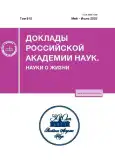INFLUENCE OF THE CULTIVATION CONDITIONS OF THE GLIOBLASTOMA NEUROSPHERE ON THE EXPRESSION OF MALAT1 AND LINCROR LONG NON-CODING RNA GENES
- Authors: Mazur D.V.1, Mishanova A.V.1, Kovalenko T.F.1, Shakhparonov M.I.1, Antipova N.V.1,2
-
Affiliations:
- Institute of Bioorganic Chemistry named after M.M. Shemyakin and Yu.A. Ovchinnikov
- Department of Biology and Biotechnology, Higher School of Economics
- Issue: Vol 510, No 1 (2023)
- Pages: 243-246
- Section: Articles
- URL: https://journals.rcsi.science/2686-7389/article/view/135690
- DOI: https://doi.org/10.31857/S2686738922600960
- EDN: https://elibrary.ru/QFAHLS
- ID: 135690
Cite item
Full Text
Abstract
ABSTRACT Glioblastoma multiforme (GBM) is the most aggressive malignant brain tumor. One of the reasons for the resistance of MGB to treatment is the extreme heterogeneity of the tumor and, in particular, the presence of cancer stem cells (CSCs) in the population of glioblastoma cells. In this work, we investigated the effect of conditions that reduce the proportion of CSCs in the GBM cell population on the levels of long noncoding RNAs (lincROR and MALAT1) involved in the formation of the phenotype of glioblastoma cancer stem cells. We have shown that culturing under conditions that cause a decrease in cell stemness (when fetal calf serum is added to the culture medium) affected the content of these transcripts: in the cells of most of the analyzed lines, a decrease in the level of the positive stemness regulator lincROR and an increase in the content of MALAT1 were noted.
Keywords
About the authors
D. V. Mazur
Institute of Bioorganic Chemistry named after M.M. Shemyakin and Yu.A. Ovchinnikov
Email: nadine.antipova@gmail.com
Russian Federation, Moscow
A. V. Mishanova
Institute of Bioorganic Chemistry named after M.M. Shemyakin and Yu.A. Ovchinnikov
Email: nadine.antipova@gmail.com
Russian Federation, Moscow
T. F. Kovalenko
Institute of Bioorganic Chemistry named after M.M. Shemyakin and Yu.A. Ovchinnikov
Email: nadine.antipova@gmail.com
Russian Federation, Moscow
M. I. Shakhparonov
Institute of Bioorganic Chemistry named after M.M. Shemyakin and Yu.A. Ovchinnikov
Email: nadine.antipova@gmail.com
Russian Federation, Moscow
N. V. Antipova
Institute of Bioorganic Chemistry named after M.M. Shemyakin and Yu.A. Ovchinnikov; Department of Biology and Biotechnology, Higher School of Economics
Author for correspondence.
Email: nadine.antipova@gmail.com
Russian Federation, Moscow; Russian Federation, Moscow
References
- Louis D.N., Perry A., Wesseling P. et al. // The 2021 WHO Classification of Tumors of the Central Nervous System: a summary. Neuro Oncol. 2021. V. 23. P. 1231–1251.
- Simon J.M., Toubiana T., Lang P. et al. // Radiotherapy for glioblastomas: from radiobiology to concomitant chemotherapy. Cancer Radiother. 2005. V. 9. P. 322–331.
- Bradshaw A., Wickremsekera A., Tan S.T. et al. // Cancer Stem Cell Hierarchy in Glioblastoma Multiforme. Front. Surg. 2016. V. 3. P. 21.
- Rao M.R.S. // Long non-coding RNA biology. Singapore: Springer Nature. 2017. 323 p.
- Loewer S., Cabili M.N., Guttman M., et al. // Large intergenic non-coding RNA-RoR modulates reprogramming of human induced pluripotent stem cells. Nat. Genet. 2010. V. 42. P. 1113–1117.
- Chen W., Yang J., Fang H. et al. // Relevance Function of Linc-ROR in the Pathogenesis of Cancer. Front. Cell. Dev. Biol. 2020. V. 8. P. 696.
- Kovalenko T.F., Yadav B., Anufrieva K.S. et al. // Functions of long non-coding RNA ROR in patient-derived glioblastoma cells. Biochimie. 2022. V. 200. P. 131–139.
- Li Z. // CD133: a stem cell biomarker and beyond. Exp. Hematol. Oncol. 2013. V. 2. P. 17.
- Ma R., Zhang B.W., Zhang Z.B. et al. // LncRNA MALAT1 knockdown inhibits cell migration and invasion by suppressing autophagy through miR-384/GOLM1 axis in glioma. Eur. Rev. Med. Pharmacol. Sci. 2020. V. 24. P. 2601–2615.
- Latorre E., Carelli S., Raimondi I. et al. // The Ribonucleic Complex HuR-MALAT1 Represses CD133 Expression and Suppresses Epithelial-Mesenchymal Transition in Breast Cancer. Cancer Res. 2016. V. 76. P. 2626–2636.
- Larionova T.D., Bastola S., Aksinina T.E. et al. // Alternative RNA splicing modulates ribosomal composition and determines the spatial phenotype of glioblastoma cells // Nat Cell Biol. 2022. V. 24. P. 1541–1557.
- Lee J., Kotliarova S., Kotliarov Y. et al. // Tumor stem cells derived from glioblastomas cultured in bFGF and EGF more closely mirror the phenotype and genotype of primary tumors than do serum-cultured cell lines. Cancer Cell. 2006. P. 391–403.
- Brewer G.J., Torricelli J.R., Evege E.K. et al. // Optimized survival of hippocampal neurons in B27-supplemented neurobasal, a new serum-free medium combination. Journal of Neuroscience Research. 1993. P. 567–576.
- Minata M., Audia A., Shi J. et al. // Phenotypic Plasticity of Invasive Edge Glioma Stem-like Cells in Response to Ionizing Radiation. Cell Rep. 2019. V. 26. P. 1893–1905.
- Freedman L.P., Gibson M.C., Ethier S.P. et al. // Reproducibility: changing the policies and culture of cell line authentication. Nat Methods. 2015. V. 12. P. 493–497.












